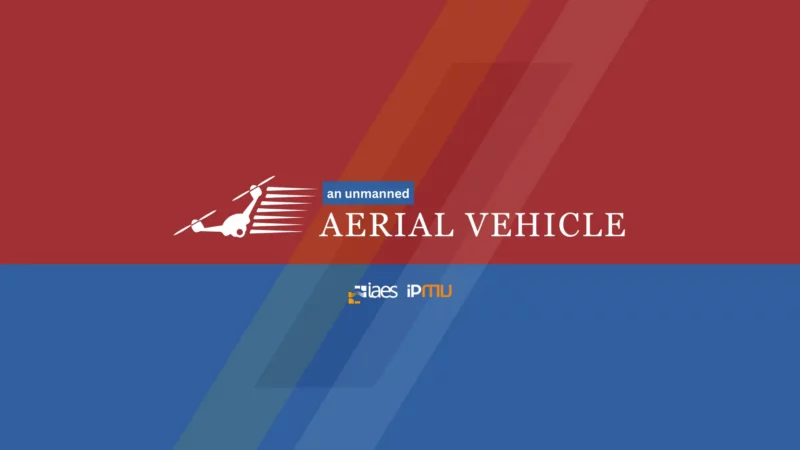Greetings, fellow Nawala! May you always be in good health.
This is the IAES Nawala of the Institute of Advanced Engineering and Science. Today we are sharing news about unmanned aerial vehicle (UAV) technology. UAVs are aircraft that operate without a human pilot on board, or commonly known as unmanned aircraft. These vehicles are often also known as drones and can be remotely controlled by a human operator. It can also operate autonomously based on pre-programmed flight plans or using artificial intelligence systems. The development of UAVs guides researchers to concentrate on solving problems such as handling complex and large-scale information and uninterrupted communication. Thangaraj and Sangam (2023) have conducted research to handle these problems using artificial neural network (ANN) and artificial potential field (APF). More detailed results of the research can be seen in:
Meena Thangaraj, Ravi Sankar Sangam
Unmanned aerial vehicles (UAVs) are utilized extensively in various fields of daily activities in the day to day life and industrial applications. The raises of utilization of UAVs guide the researchers to concentrate on various problems like handling rich and large-scale information and uninterrupted communication. Further, to achieve the above the obstacle free zone is mandatory and the present autonomous drones may fail to handle such situations. To address the mentioned issues, an effective path planning algorithm is needed, to find the optimal path and obstacle free mobility. Hence, UAV path planning needs intelligent and autonomous navigation system by providing high level of optimization in order to attain optimal path with the obstacles avoidance. In this paper, AI employed framework for UAV path planning is proposed by utilizing the salient features of both artificial neural network (ANN) and artificial potential field (APF). ANN is implemented for obtaining optimal path and APF is utilized for evading the obstacles throughout the path. Further, the implementation results show the better performance than the existing works in terms of the collision free optimal path for UAVs.
The development of UAV technology is not limited to the development of the device itself. Ai et al. (2023) developed a UAV support device, called reconfigurable intelligent surfaces (RISs) assisted. With the development of RIS-assisted, it can minimize the error-rate of UAV devices. In addition, RIS-assisted can also increase the coverage and reliability of UAV devices. The research can be seen in full in the following article:
Duong Huu Ai, Van Loi Nguyen, Hoang Huu Duc, Khanh Ty Luong
In this study, to reduce the average symbol error rate, and improve coverage and reliability of unmanned aerial vehicles (UAVs) to ground communication systems. In this case, we propose a reconfigurable intelligent surfaces (RISs) assisted for UAV to ground communication scheme, where radio frequency (RF) signal generator sends an unmodulated carrier signal from UAVs to the RIS. At reconfigurable intelligent surface, the RIS modulates each signal, and RIS is as a signal generator. We carry out a performance analysis of UAV-to-ground communication systems with RIS-assisted and without RIS for subcarrier quadrature amplitude modulation (SC-QAM) technique. The analytical expressions of average symbol error rare (ASER) and average channel capacity (ACC) is derived. From the results, it is show that with RIS assisted can effectively improve the reliability and coverage of the UAVs to ground communication systems.
Do and Le (2022) conducted research related to the integration between non-orthogonal multiple access (NOMA) and UAVs. They discussed the performance analysis of a scenario where UAVs communicate in a NOMA-based cognitive radio network (CR-NOMA) with two destination users, namely a mobile device and a primary destination that follows the Nakagami-m fading distribution. A more detailed description of the results obtained can be found in the following article:
UAV-assisted underlay CR-NOMA network: performance analysis
Dinh-Thuan Do, Chi-Bao Le
We highlight the potential of non-orthogonal multiple access (NOMA) integration with unmanned aerial vehicle (UAV) for future communications networks in beyond 5 generation (B5G) networks to enhance cellular communication, support massive connections and increase data rates. We consider a scenario, where a UAV communicates in a downlink underlay cognitive radio based NOMA network (CR-NOMA) with two destination users, a cellular device, and a primary destination following Nakagami-m fading distribution. We study the impact of perfect and imperfect successive interference cancellation (SIC) on outage probability (OP). To help analyze this impact, we derive exact outage results for different network users under perfect and imperfect SIC conditions. Consequently, we make use of Monte Carlo simulations to confirm the analytical results.
The above articles are a small part of the research on unmanned aerial vehicle (UAV) technology. To get more information, readers can visit the page and read articles for FREE through the following links: https://ijeecs.iaescore.com/, http://telkomnika.uad.ac.id/, and https://beei.org/.
By: I. Busthomi

